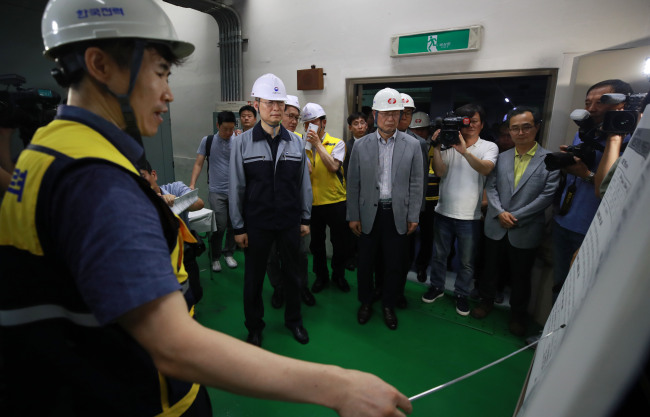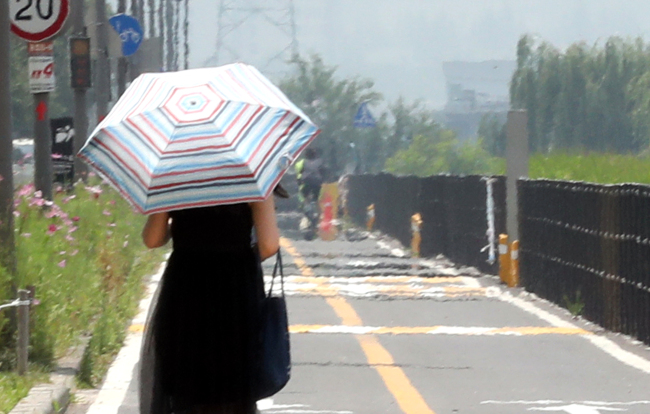Scorching heat leads to electricity failures, casualties
By Jo He-rimPublished : July 22, 2018 - 16:48
As the scorching weather continues, several regions across South Korea suffered blackouts caused by circuit failures following high electricity demands.
According to Korea Electric Power Corp. on Sunday, the electricity went out in 756 households of nine apartment buildings in Gwangju at 10:10 p.m. on Saturday. While the power came back for most of the houses after two hours, the outage continued as of Sunday noon for 252 households in the three apartment buildings.
According to Korea Electric Power Corp. on Sunday, the electricity went out in 756 households of nine apartment buildings in Gwangju at 10:10 p.m. on Saturday. While the power came back for most of the houses after two hours, the outage continued as of Sunday noon for 252 households in the three apartment buildings.

In Busan, 200 households suffered from an electricity outage from 10:30 p.m. to 2 a.m. on Sunday.
Districts in Seoul also suffered similar blackouts on Saturday. In an apartment complex at Gangseo-gu, the power went out for two minutes for 1,600 households at 6:03 p.m. In Nowon-gu, the power failure occurred to 690 households in an apartment complex for 40 minutes at around 9 p.m. A thousand households also suffered a blackout for a couple of hours in Dongdaemun-gu.
Kepco thinks the power failures occurred because electric transformers overloaded.
“When power outage occurs, people should not try to fix it on their own, but dial 123 for help as it can cause a short circuit," an official from the Ministry of Interior and Safety said.
The number of death toll increased with the intensive heat.
A 21-year-old autistic man died after staying in a car parked under scorching sun for hours in Hongseong, South Chungcheong Province.
According to the provincial fire department, the victim had passed out inside a car near an apartment complex when he was found by the car owner at 12:17 p.m. on Saturday.
The victim was transferred to a nearby hospital by the rescue team immediately after discovery, but died. He suffered symptoms of heat cramps and his body temperature rose to as high as 42 C at the time, the fire authorities said.
The owner of the car had parked the car without locking the door at around 6 p.m. on Friday, and found Lee inside the car the next day. The day time high reached 35.9 C in Hongseong on the day.
The autistic victim had a cognitive disorder and could not open car doors, according to the mother’s testimony to the police.
According to Korea Centers for Disease Control and Prevention, over 469 cases of heat-related illnesses were reported last week.
On Sunday, the daytime highs hovered around 33 to 37 decrees C across the country. The government is reviewing whether to revise the disaster law to include intensive heat as a disaster.

“We have decided great heat should be included in the list of natural disasters. The ministry will express support to the National Assembly when it reviews revision of the related laws,” an official from the Ministry of the Interior and Safety said.
The current Act on the Management of Disasters and Safety defines “natural disasters” as situations caused by weather conditions such as typhoons, floods, droughts, earthquakes and meteorites. But the list does not include intense heat.
The ministry appears to change its stance from a year ago, when it said a heat wave could not be categorized as a disaster. At the time, the National Disaster and Safety Status Control Center maintained it was taking proper measures to deal with heat-related problems, and that temperature fluctuations following seasonal changes were predictable.
By Jo He-rim (herim@heraldcorp.com)








![[Graphic News] More Koreans say they plan long-distance trips this year](http://res.heraldm.com/phpwas/restmb_idxmake.php?idx=644&simg=/content/image/2024/04/17/20240417050828_0.gif&u=)
![[KH Explains] Hyundai's full hybrid edge to pay off amid slow transition to pure EVs](http://res.heraldm.com/phpwas/restmb_idxmake.php?idx=644&simg=/content/image/2024/04/18/20240418050645_0.jpg&u=20240419100350)







![[KH Explains] Hyundai's full hybrid edge to pay off amid slow transition to pure EVs](http://res.heraldm.com/phpwas/restmb_idxmake.php?idx=652&simg=/content/image/2024/04/18/20240418050645_0.jpg&u=20240419100350)

